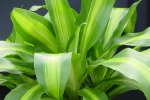Dracaena is a native plant from tropical and subtropical forests of Southeast Asia and Africa. Under this name there are known both Cordelia and Dracaena and often florists sell them as being one and the same plant. The plants’ name comes from the Greek “drakaina” and means “dragon woman”.

Both plants (Dracaena and Cordelia) have long, narrow, green or black leaves. It’s easy to distinguish these plants by their roots. Dracaena does not have rhizomes, its roots are yellow, and the leaf veins are parallel.
Cordelia seems to be different because it has thickened underground stems. These are underground rhizomes and shoots, with runners, from where the new plants grow. It has annual white roots which are dying near the spring, but the new ones appear simultaneously.
Both Dracaena and Cordelia are some false palm trees because of the trunk which does not have leaves but a bunch of leaves at the top. For example, Dracaena blooms around the nature and its flower is actually a shrub with white tiny flowers, but Dracaena is chosen to be cultivated inside. This is due not to its flowers but as a decorative plant with interesting leaves, used to decorate hallways and lounges.
All Dracaenas must be watered properly. The soil should not be allowed to get dry, but even so you do not have to drown the plant. Dracaena prefer moist climate, so you have to spray water on it regularly, putting the pot on damp peat or wet gravel. You should check carefully the Dracaena’s leaves; if their tips are yellow it means that the environment’s humidity is not good enough. You should sprinkle the plant with water to prevent soil hardening. Another cause of this phenomenon is cold air and drafts. If the leaves slowly turn yellow, it is a natural process of withering and you have nothing to worry about.
Once in every two weeks during the summer and once a month in winter, it is good to use a fertilizer. Dracaena must be moved in another pot every two years, in spring. Mature plants should be moved only when the pot is too small. In case of these plants, just change the top layer of the soil.
Dracaena is getting sick very rarely, if the maintenance is appropriate. The leaves are drying if the plant does not have enough water. If direct sun burns the leaves, there are appearing light-colored dry spots on them. In this case you need to spray water over the leaves regularly, or find a better place for the plant.
Dracanea Pictures Gallery



